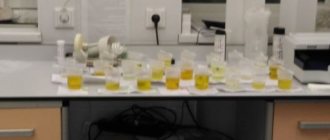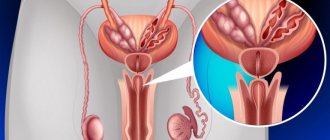Urology
1194
no comments
Everyone is accustomed to the fact that human urine has a yellowish tint, or, as doctors say, straw yellow. This is a truism. During the day, urine may change color slightly. So, in the morning it is usually brighter and more concentrated. If a person drinks a lot of liquid during the day, it becomes a little lighter, and may even become almost transparent. But what does it mean if it suddenly changes color? Has it turned brown, for example? What could be the reasons for such changes in the body of men?
Reasons for changes in urine color after drinking alcohol
Alcohol has a negative effect on all internal organ systems, without exception. The kidneys are not spared either, and perhaps these main filters of the body suffer the most. After heavy drinking, changes in urine color are associated with the following factors:
- Ethyl alcohol negatively affects the filtration capacity of the kidneys.
- Ethanol and acetaldehyde destroy kidney cells, so the organs are unable to perform their work normally.
- Under the influence of alcohol, the excretory system begins to work in emergency mode, a large volume of blood is pumped through the nephrons to remove toxic substances from the body.
- Alcoholic drinks provoke dehydration of the body, which cannot but affect the color of urine.
Even in a healthy person, the color of urine can determine the lack of fluid. If it is too dark, then this is a signal that the body is suffering from a lack of water.
After heavy drinking, urine color may change
- Under the influence of ethyl alcohol, blood thickens, which complicates the filtration process. These disturbances are immediately reflected on the face in the form of swelling in the morning.
There is a misconception that beer does not cause as much harm as vodka. On the contrary, this drink is most dangerous due to severe dehydration. First, the body spends a lot of moisture to remove the toxic breakdown products of alcohol, and then the blood thickens and filtration becomes very difficult.
How does urine color change?
During a hangover, many drinkers' urine turns dark. Even a one-time dose leads to a disruption in the chemical composition of urine, which certainly affects its color. Cloudy urine after drinking alcohol is a symptom of the appearance of protein in it, which should not be the case under normal conditions. This is due to impaired filtration capacity of the kidneys.
If dark-colored urine persists for several days even after stopping drinking alcohol, this may indicate serious abnormalities in the functioning of the kidneys, problems with the bladder and urinary ducts.
Urine color: normal and disease
The following complications are the most common:
- Dystrophic changes in the kidneys.
- Development of acute renal failure.
- Exacerbation of chronic kidney pathologies.
In chronic alcoholics, changes in urine color may be associated with the development of liver cirrhosis.
After stopping drinking alcohol, the color of urine returns to normal within a few days; if this does not happen, you need to visit a doctor to find out the cause. You will have to get tested and undergo an examination.
Clots
Blood clots in urine are more common; they indicate the release of fluid into the genitourinary system. They can form in the form of small or large flakes, clearly visible against the background of a uniformly colored liquid.
The reasons for this phenomenon may be:
- blood pressure surges;
- mechanical damage to the urinary tract;
- glomerulonephritis or destruction of the kidney structure;
- metabolic disorders and other kidney diseases;
- oncological diseases affecting the genitourinary system;
- urolithiasis disease;
- formation of stones in the kidneys or prostate gland and others.
Blood in the urine
While cloudy urine and its dark color may not be so dangerous, blood in the urine is a serious symptom that cannot be ignored.
An admixture of blood signals pathologies of the urinary system. In rare cases, a serious blood disease - hemophilia. To make a diagnosis, you need to consider some factors:
- Is there pain when urinating?
- What is the amount of blood in the urine?
- During what phase of urination is blood released?
- Are there any blood clots?
Most often, the appearance of blood after drinking alcohol indicates the presence of the following pathologies:
- Exacerbation of urolithiasis due to alcohol consumption.
- Tumors in the kidneys.
- Infectious pathologies of the urinary tract.
- Chronic prostatitis.
- Development of alcoholic hepatitis.
- Cirrhosis of the liver.
- Oncological pathologies of the liver or pancreas.
An admixture of blood signals pathologies of the urinary system
To make a diagnosis, it is important for the doctor to know when blood appears in the urine: at the beginning or at the end of urination. If an admixture of blood droplets is detected at the beginning, then this is a clear symptom of urethritis; if at the final stage of urination, then most likely there is an inflammatory process in the bladder.
If after a feast blood appears in the urine, then this is a clear indication to urgently visit a doctor. If a change in the color of urine is associated with serious pathologies that are provoked by alcohol intake, then, as a rule, other symptoms appear: lower back pain, pain during urination, nausea, and body temperature may rise.
Even a completely healthy person will feel symptoms of kidney dysfunction after excessive libation, but what can we say then about those who already have a whole bunch of diseases.
Constant drunkenness disrupts the water-salt balance in the body, which leads to a serious disorder and the kidneys can no longer cope with their duties. The fluid that needs to be removed accumulates, causing severe swelling. And along with it, toxic substances remain after the breakdown of ethanol, which leads to intoxication.
Burning
This symptom also serves as an alarming signal. Blood in the urine with a burning sensation means that there is a bacterial infection in the system. It can appear due to decreased immunity or promiscuity, often accompanies STIs.
Often, droplets of blood during urination are not the only sign. Against the backdrop of this problem, we observe:
- Difficulty releasing urine from the urethra in the morning. Urine is released in droplets or it is impossible to urinate at all.
- Vomiting and nausea. In case of kidney disease, fever and vomiting are among the first symptoms.
- Stomach upsets. In case of poisoning, diarrhea with blood may occur.
- Symptom of prostatitis. Pain appears after urination.
- There is ichor and purulent sediments, and there is a strong smell of urine. The appearance of such signs can be observed after sex.
- Mucus secretion. Bleeding and a strong-smelling discharge are symptoms of infections.
- Increased pain and constant desire to urinate in the morning.
Darkening of urine after heavy drinking is rarely the only symptom of pathology, but this is a reason to consult a doctor. Acute alcoholic hepatitis is a serious disease that ends in death in 10-30% of alcoholics. Sometimes the only sign is dark urine after binge drinking. But other symptoms often appear:
- yellowing of the skin, sclera of the eyes
- dull pain in the right hypochondrium
- nausea, vomiting, often bile
- decreased or complete lack of appetite
- stool discoloration
- itchy skin
- lower back pain in the kidney area
- febrile state
We invite you to read What does it mean to code a person?
Sometimes hepatitis is combined with pancreatitis, which worsens the condition and prognosis for the patient. He requires hospitalization and medical care.
The effect of alcohol on urine
The first advice to those who suddenly see that their urine has darkened is to calm down and not panic. This is advised by all doctors - urologists, psychologists.
We need to calmly analyze the events that preceded this change. There are many factors that affect the color of urine.
A healthy person is accustomed to the fact that his urine is usually light yellow, although under the influence of various factors it can change color several times a day.
The effect of urobilin on urine color
The yellow color of urine is due to the presence of urobilin, which has yellow tones. At night, when a person sleeps, the amount of urobilin may increase, giving morning urine a slightly darker hue.
But then, when a person begins to drink water, especially if in large quantities, the urine can become almost completely clear. If a person is healthy and drinking alcohol is a rare occurrence for him, then the color of urine after drinking alcohol should not differ from usual.
If everything was fine the day before, a person drank a little alcohol in the evening, and in the morning he saw that his urine had darkened, one should not immediately conclude that this dark color of urine appeared after alcohol.
It is advisable to remember what he ate and drank in the evening. Perhaps there were drinks containing dyes, or there were carrots and beets on the menu.
By the way, it is beets that give men’s urine a red color not only after alcohol. It is very easy to check whether beets were the culprit of the red urine.
Checking urine with soda for possible staining with beets
To do this you need:
- collect some urine in a clean glass container;
- pour a little regular baking soda into the vessel;
- pour a tablespoon of vinegar here.
If the liquid turns white and then turns red again, then you can rest assured that the culprit is beets.
Darkening of urine after alcohol - what does it mean?
The appearance of brown urine after alcohol is a fairly common occurrence in men. And after one glass of alcohol, a protein component may appear in the urine, which in principle should not be there.
Dark urine due to kidney necrosis
Excessive amounts of alcohol-containing drinks consumed cause renal necrosis, which is manifested not only by the presence of protein in the urine, but also by the presence of blood in the urine, caused by profound disorders of the renal blood and lymph circulation. The presence of blood in urine can be detected with the naked eye.
And if this happens, then measures should be taken immediately. If you do not stop regular drinking, this isolated case can develop into a disease of the kidneys and the entire genitourinary system.
Health care
It may not be only after alcohol that urine is dark in color in men. If all foods that could affect the color of urine have been excluded from the daily diet, if medications that affect its pigmentation have been stopped, but it still does not lighten and remains dark for a sufficiently long period of time, this already falls under symptoms of a serious illness. This could be inflammation of the prostate gland, urolithiasis.
In men who abuse alcohol, red urine after alcohol may indicate a whole bunch of pathologies:
- alcoholic hepatitis;
- cirrhosis of the liver;
- oncological diseases of the liver and pancreas;
- kidney diseases.
If urination is accompanied by pain, then this is the first sign that the patient has problems with the kidneys, bladder and urine excretion ducts.
Products that give color
Some foods give urine an orange color. This occurs due to the consumption of vegetables or fruits enriched with the pigment carotene. Among them are orange-red products:
- citrus;
- carrots (and carrot dyes can change the color of the skin and sclera);
- pumpkin.
Blackberries, raspberries, and other foods rich in pigment substances change the color of urine. Stores sell a large number of products containing food coloring. Fruit juice, lemonade, and candy can give urine an orange color.
Causes of dark urine
In 80% of cases, urine acquires an amber or honey hue due to disruption of physiological processes when dehydration occurs (vomiting, diarrhea). Associated symptoms of insufficient fluid in the body are:
- dizziness;
- dry mouth;
- dry skin;
- headache;
- thirst;
- constipation.
Sometimes darkening of urine has nothing to do with dehydration or the presence of diseases in the body. In this case, the color change occurs as a result of consuming certain foods or medications. Beets, chocolate, berries, rhubarb and split peas can cause dark-colored urine. Medicines may include: laxatives with senna, chemotherapy drugs, Rifampicin, Warfarin and Phenazopyridine.
Dark urine in men after drinking alcohol causes poisoning of the body, which contributes to the release of red blood cells into the urine.
A change in urine color may indicate a disease in one of five organs:
Liver
is responsible for the processes of processing waste products of the body. Damage to the tissues of this organ in diseases such as cirrhosis, jaundice, hepatitis, cancer, infectious mononucleosis, increases the destruction of red cells, as a result of which the urine becomes coffee or brown in color.
Other symptoms of liver disease may include an enlarged belly, easy bruising or bleeding, as well as nausea and loss of appetite.
Bile and bile ducts
play an important role in metabolic processes. An increase in the level of the bile pigment bilirubin causes urine to turn dark beer-colored. The causes are the following ailments: cholestasis, duct tumors, stone formation, parasites.
Kidneys
― the main organ of urination, its poor functioning leads to the appearance of red blood cells and pus in the urine, which acquires a dirty red color.
These changes occur with glomerulonephritis, pyelonephritis, kidney disease, and polycystic disease. Internal inflammatory processes in the genital organs
lead to the appearance of blood-red urine, which may be associated with a tumor in the testicles, prostate adenoma, orchitis, stones in the urethra, and open injuries of the groin area.
Bladder dysfunction
and urethra lead to an increase in the number of leukocytes and clouding of the urine. Changes are caused by infectious diseases such as urethritis, cystitis, nephrolithiasis, schistosomiasis.
Associated symptoms
The appearance of dark urine in the morning for two or more days is a dangerous symptom, so you should pay attention to accompanying signs, such as the unpleasant smell of urine, nagging pain in the pubic area, lower back and right hypochondrium. If these complications occur, you should immediately make an appointment with a therapist or urologist.
Fluctuating blood pressure, swelling of the legs, increased temperature, burning in the perineum, and painful urination are also reasons to go to the doctor.
When do you need to see a doctor urgently?
What to do if a change in shade causes concern? Determine the cause: exclude provoking natural factors, monitor the change in shade throughout the day. The next morning, collect urine in a jar: the appearance of mucus, turbidity, and blood is clearly a reason to visit the doctor. The following factors require immediate contact with a urologist:
- Black, orange, red and other discolored colors last more than two days and do not depend on natural causes, time of day or number of drinks;
- Skin rashes appeared on the chest, stomach, and groin;
- The genital organ turned red, itching and burning appeared;
- Urination is painful;
- The feeling of an incompletely emptied bladder lasts more than 2 days;
- The amount of fluid has decreased or increased significantly, but there are no provoking factors;
- Pain in the lower back, groin, legs, perineum, pubic area.
If a man experiences any of the signs, see a urologist immediately! The doctor will order tests to determine the cause of the problem, as well as possible ways to eliminate it. Diagnostic procedures are not limited to urine analysis; ultrasound, x-rays and other instrumental studies are prescribed and everything that a specialist deems necessary.
What to do if you notice symptoms
Before consulting a doctor, a man should observe the color of the urine excreted for two days, determine the presence of impurities, suspensions, blood drops in it, and pay attention to how it smells. It is important to control the amount of liquid consumed and make sure that there are no coloring foods in the diet. Darkening often occurs for non-pathological reasons.
If there are accompanying symptoms and this phenomenon lasts more than two days, you should consult a urologist. At the appointment, the doctor will take an anamnesis and conduct an initial examination of the genitals and abdominal area to detect redness, pain and burning. Next, urine tests (general and biochemical) are sent to the laboratory.
For analysis, the first morning portion of urine is taken and stored for no more than an hour in a dark place. When exposed to sunlight, the urochrome pigment will begin to oxidize to bilirubin, which will lead to darkening of the urine.
If pathological processes of internal organs are suspected, the urologist sends the patient for ultrasound examination of the kidneys, liver or urethra. An ultrasound is performed on an empty stomach, using a special conductive gel; this examination allows you to identify changes in the structure and size of the organ, its darkening or damage.
Diagnosis of diseases
It is possible to give the correct answer to the question why urine is brown only after a series of examinations and consultations. There are many pathological reasons for darkening of urine, not all of them are recognized by their manifestation of external symptoms. Do not neglect personal hygiene measures or ignore recommendations for the use of mechanical contraceptives.
Self-medication is unacceptable. Only the results of laboratory, instrumental and instrumental studies provide the basis for analysis and understanding of why brown urine or brown discharge is observed in urine.
To diagnose diseases the following is used:
- ultrasound examination of the body;
- computer and magnetic resonance imaging;
- laboratory general and biochemical blood tests;
- various urine tests;
- laboratory tests of smears and discharge samples;
- antibiotic sensitivity tests;
- instrumental examination of the urethra;
- laboratory studies of viral pathologies.
Modern medicine has a wide range of possibilities for correctly diagnosing diseases and choosing adequate but effective tactics to combat it.
Principles of treatment
Treatment depends on the organ in which the pathology is detected and the degree of damage. General principles are restoration of water balance, control of food intake, antibacterial therapy.
To normalize liver function, drug therapy is prescribed with the drugs Karsil (improves microcirculation inside cells), Ursonan (restores liver cells), Eslidin (supports protein and fat metabolism). The therapeutic method is the use of droppers with a solution of ascorbic acid to eliminate the effects of toxins on the liver.
In case of serious diseases of the organ, a transplant is required. The procedure is performed through an incision in the patient's abdomen, a tube is inserted into the bile duct to drain bile, the blood vessels are cut, and the blood is pumped to the heart from the legs using a pump. The diseased liver is removed, and the donor liver is transferred into the body, the vessels and bile ducts are sutured, in 40% of cases the transplanted organ does not take root.
Kidney diseases such as pyelonephritis and glomerulonephritis are treated in a hospital. The patient is prescribed bed rest, taking antibacterial and immunosuppressive drugs. In difficult cases, hemodialysis is required - purification of blood outside the kidneys through a vascular catheter. It is carried out using a dialyzer - a semi-permeable cellulose membrane through which blood is filtered.
For kidney stones, drugs are used to dissolve stones, such as Phytolysin, Canephron. In case of complications, surgical intervention is required - lithotripsy - laser surgery to crush and remove kidney stones.
Diseases of the reproductive system are most often infectious, so the patient should take antibacterial drugs - Cefatoxime, Ciprofloxacin and others. An operation is required when pus is detected in the testicles, then dissection and removal of purulent contents are performed.
For prostate adenoma, transurethral resection or adenomectomy is performed, during which excess tissue compressing the urethra is removed. The first operation is endoscopic - the device is inserted through the urethra, the second procedure is open, when an incision is made on the abdomen.
In the case of cystitis or urethritis, drug treatment is most often prescribed using antibacterial, immunomodulating drugs, as well as local antiseptics that are injected into the urethra. If conservative treatment methods are ineffective, an epicystomy is required - scraping out the dead mucous membrane of the bladder.
Schistosomiasis occurs when schistosome eggs are present in the body and can be effectively treated with drugs such as Praziquantel or Albendazole.
Prevention
There is a scale for deciphering the color of urine, which shows changes in color due to certain diseases and disorders, but to confirm and prescribe the appropriate treatment, you should consult a specialist.
A number of non-pathological factors can lead to darkening of urine, which can be prevented using the following recommendations:
- visiting a urologist at least twice a year;
- avoidance of caffeine, alcoholic beverages and nicotine;
- proper nutrition (cereals, plenty of vegetables and fruits);
- reducing the consumption of trans fats (fast food), fast carbohydrates (cookies, chocolate);
- a moderate amount of fluid consumed, which is at least two liters per day;
- daily physical activity (running, swimming, yoga);
- compliance with personal hygiene rules, absence of unprotected sexual intercourse;
- promptly consult a doctor if the color of urine changes.











